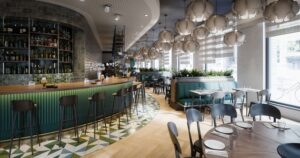Shopping centers have evolved from mere retail hubs into dynamic destinations that offer a holistic experience. Beyond shopping, modern consumers seek entertainment, social engagement, and a diverse culinary journey when they visit these centers. This shift in consumer expectations has driven the need for innovative restaurant designs that not only provide delicious food but also create memorable atmospheres. This is where restaurant design consultants play a pivotal role.
In this comprehensive guide, we will delve into the world of restaurant design in shopping centers. We will explore the strategies employed by restaurant design consultants to create spaces that captivate, engage, and leave a lasting impression on patrons. From conceptualization to execution, this journey will reveal the intricate details that make a restaurant in a shopping center a thriving success.
Understanding the Shopping Center Ecosystem
Before diving into the nitty-gritty of restaurant design, it’s essential to comprehend the unique dynamics of a shopping center. These centers are bustling hubs where foot traffic is abundant, and competition among various businesses is fierce. To design a restaurant that stands out, restaurant design consultants must take several factors into consideration:
A. Location Analysis
- Visibility and Accessibility: Consultants evaluate the restaurant’s location within the shopping center, ensuring it is easily visible and accessible to shoppers.
- Foot Traffic Patterns: Studying foot traffic patterns helps in determining the best spot for the restaurant, ensuring it receives a steady flow of potential customers.
B. Target Audience
- Demographics: Consultants analyze the shopping center’s demographics to understand the preferences and tastes of potential patrons.
- Competition: A thorough assessment of existing dining options in the shopping center helps identify gaps and opportunities for differentiation.
Concept Development and Branding
With a clear understanding of the shopping center’s ecosystem, restaurant design consultants proceed to develop a unique concept and brand identity for the restaurant:
A. Theme and Ambiance
- Conceptualization: Consultants work closely with restaurant owners to brainstorm and define the restaurant’s theme and ambiance, which should align with the shopping center’s overall vibe.
- Storytelling: Crafting a compelling narrative that resonates with patrons is crucial for building an emotional connection with the restaurant.
B. Branding Elements
- Logo and Visual Identity: Designing a memorable logo and visual identity that reflects the restaurant’s concept.
- Menu Design: Creating a visually appealing menu that complements the restaurant’s brand.
Interior Design and Layout
The interior design of a restaurant in a shopping center is a delicate balance of aesthetics, functionality, and customer comfort:
A. Layout Planning
- Seating Arrangement: Consultants determine the optimal seating arrangement, considering factors like table size, spacing, and flexibility.
- Flow and Accessibility: Ensuring a smooth flow of patrons and easy access for staff.
B. Aesthetics
- Color Scheme and Lighting: Selecting a color scheme and lighting that aligns with the restaurant’s concept and enhances the overall dining experience.
- Furniture and Decor: Choosing furniture and decor elements that not only look great but are also durable and comfortable.
Kitchen and Workflow Design
Behind the scenes, the kitchen and workflow are meticulously designed for efficiency and productivity:
A. Kitchen Layout
- Workflow Optimization: Organizing the kitchen layout to optimize the flow of food preparation and service.
- Equipment Selection: Choosing the right kitchen equipment based on the restaurant’s menu and capacity.
B. Safety and Compliance
- Health and Safety Regulations: Ensuring that the kitchen design adheres to health and safety regulations.
- Sustainability: Incorporating sustainable practices into kitchen design, such as energy-efficient appliances.
Technology Integration
In the digital age, technology plays a significant role in enhancing the dining experience in shopping center restaurants:
A. Point-of-Sale Systems
- Efficiency: Implementing POS systems that streamline order taking and payment processes.
- Data Analytics: Leveraging POS data for insights into customer preferences and operational efficiency.
B. Customer Engagement
- Online Ordering and Reservations: Integrating online ordering and reservation systems for added convenience.
- Social Media Integration: Utilizing social media and technology to engage with customers and gather feedback.
Sustainability and Environmental Considerations
Modern consumers are increasingly conscious of sustainability, and restaurant design consultants must integrate eco-friendly practices:
A. Eco-Friendly Materials
- Recycled and Sustainable Materials: Choosing building materials that have minimal environmental impact.
- Energy-Efficient Lighting and Appliances: Reducing energy consumption through smart lighting and appliances.
B. Waste Reduction
- Waste Management: Implementing effective waste management systems to minimize environmental impact.
- Local Sourcing: Promoting sustainability by sourcing ingredients locally.
Conclusion
Designing a restaurant in a shopping center is a multifaceted endeavor that combines artistry, practicality, and business acumen. Restaurant design consultants bring together these elements to create culinary destinations that not only serve delectable food but also immerse patrons in unforgettable experiences. From location analysis to interior aesthetics, technology integration to sustainability initiatives, every facet of restaurant design contributes to its success in a shopping center ecosystem.
In an era where dining out is as much about the experience as it is about the cuisine, the role of restaurant design consultants has never been more vital. They are the architects of these modern-day gastronomic havens, where patrons savor not just food but moments that linger in their memories. As shopping centers continue to evolve, so too will the art and science of restaurant design, ensuring that these culinary destinations remain at the heart of the shopping experience.

